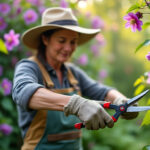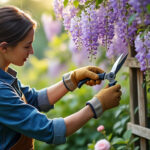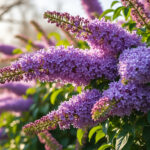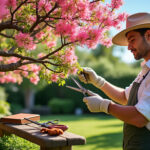This article serves to provide comprehensive insights into the optimal timing and techniques for pruning Buddleia, widely recognized for its stunning blooms that attract pollinators. Understanding these practices is essential for maintaining the health and aesthetic appeal of this shrub.
Understanding the Importance of Pruning Buddleia
Pruning Buddleia, commonly referred to as the butterfly bush, is not merely an aesthetic endeavor; it is a fundamental practice that enhances the plant’s vitality and flowering potential. The shrub is widely appreciated for its vibrant, fragrant blooms that attract butterflies 🦋 and other pollinators, creating a lively garden environment. However, to maintain optimal health and encourage prolific flowering, it is crucial to engage in proper pruning techniques.
Regular pruning has multiple benefits:
- Promotes robust growth by removing dead or diseased branches 🌱.
- Enhances flowering, as most varieties produce blooms on new wood, meaning recent growth is essential for a stunning display 🌼.
- Improves air circulation through the shrub, minimizing the risk of disease and pest infestations.
Without regular maintenance, Buddleia can become leggy, produce fewer blooms, and lose its ability to attract the very pollinators that gardeners cherish. For instance, in regions where Buddleias are left unpruned, it is not uncommon to observe stunted flower production, leading to a disappointing display in gardens. Thus, understanding how to prune correctly is pivotal to getting the most out of this beloved shrub.
Determining the Best Time for Pruning
Timing is critical when it comes to pruning Buddleia. The best period to conduct this task largely depends on the climate and specific variety of the plant. Generally, early spring is regarded as the ideal time for this operation. Pruning during this period allows for ample time for the plant to generate new shoots, which will bear flowers during the summer months.
Here is a detailed outline of the ideal pruning periods:
| Timing | Description | Recommended Action |
|---|---|---|
| Early Spring (March) | Just before new growth begins, ensuring vigorous new shoots. | Perform a hard prune cutting back to 20-50 cm (8-20 inches). |
| Late Spring (May) | For those who prefer a longer blooming period or have late-flowering cultivars. | Delay pruning until after the risk of frost has passed. |
| After Flowering (Autumn) | Light pruning to maintain shape can be done after flowering ends. | Trim off any dead or leggy growth to encourage new growth next season. |
In regions that experience heavier frost, it is crucial to monitor local weather conditions closely. Late frosts can damage freshly pruned wood, leading to further complications for the plant’s growth. Therefore, careful consideration of environmental factors plays a role in determining the exact timing for pruning Buddleia.
Effective Techniques for Pruning Buddleia
Proper techniques are just as important as timing in ensuring the success of Buddleia pruning. Utilizing the right tools and methods can significantly enhance the results. The following steps outline a structured approach to effective pruning.
- Gather Required Tools: Essential tools include pruning shears for thinner branches, loppers for thicker stems, gloves for hand protection, and disinfectant to sterilize tools. Having the right equipment will facilitate cleaner cuts and reduce the risk of harming the plant.
- Perform a Hard Prune: Trim the plant aggressively to a height of about 20-50 cm (8-20 inches). This may seem drastic, but these measures encourage fresh growth, leading to a more vibrant bloom in the summer. Removing weak or damaged branches helps direct the plant’s energy toward healthier shoots, increasing overall vigor.
- Shape the Plant: It’s essential to create an open, balanced form that allows sunlight and air to penetrate all areas of the plant. This practice not only improves aesthetics but also bolsters health by minimizing chances of disease.
Furthermore, regular maintenance throughout the growing season is crucial. In particular, deadheading—removing spent flowers—can significantly extend the blooming period, encouraging the plant to focus its energy on producing new flowers instead of seeds. As each flower fades, a simple trim below the spent bloom will suffice.
Post-Pruning Care for Optimal Results
Once the pruning process is complete, it’s crucial to implement post-pruning care to ensure the best outcomes for the Buddleia. Providing the right nutrients and conditions can significantly influence the plant’s recovery and flowering.
- Fertilize: Consider applying a balanced fertilizer or organic compost around the base, as this helps provide essential nutrients for vigorous regrowth after trimming.
- Mulch: A layer of mulch around the base of the plant can effectively retain moisture, suppress weeds, and regulate soil temperature, creating an ideal environment for growth.
- Monitor Watering: Aim to keep the soil evenly moist but ensure it is not waterlogged. This balance is especially important during the active growing season, as overwatering can lead to root rot.
Engagement with the plant’s health post-pruning assures a vibrant and thriving shrub, which can be immensely satisfying for any gardener. Neglecting this stage can lead to issues such as stunted growth and diminishing flower production.
When is the best time to harvest butternut squash?
Avoiding Common Pruning Mistakes
Even with a structured plan, several common pitfalls can hinder the successful growth of Buddleia. Awareness of these mistakes can help in achieving the desired results.
| Common Mistakes | Consequences | Prevention Strategies |
|---|---|---|
| Pruning at the Wrong Time | Can lead to reduced flowering potential as the plant needs time to develop new growth. | Stick to early spring as the primary pruning window, considering local climate conditions. |
| Skipping Deadheading | Results in seed production, which significantly diverts the plant’s energy away from flowering. | Regularly check blooms and remove spent flowers systematically. |
| Ignoring Weak Growth | Can increase susceptibility to pests and diseases, reducing overall plant health. | Conduct thorough assessments, removing damaged or weak branches to promote strength. |
Being vigilant about these common pruning issues can save significant time and effort in maintaining healthy and vibrant Buddleias. Taking a proactive approach ensures that the plant’s health is not compromised by easily avoidable mistakes.
Frequently Asked Questions
Here are some essential questions regarding Buddleia pruning, aiding gardeners in making informed decisions:
- Q: Can I prune Buddleia in the fall? A: Light pruning to remove spent blooms can be performed in the fall, but heavy pruning is best left until early spring to avoid frost damage.
- Q: What should I do if I accidentally cut too much? A: Buddleia is resilient and can recover from extensive pruning. Ensure to provide extra care, including consistent watering and fertilizing.
- Q: Do all Buddleia varieties require the same pruning techniques? A: Most varieties generally benefit from similar pruning strategies; however, some may have unique requirements that warrant further research.
This information serves to empower gardeners to take charge of their gardening efforts, ensuring that their Buddleia shrubs remain healthy and provide excellent blooms year after year.
















